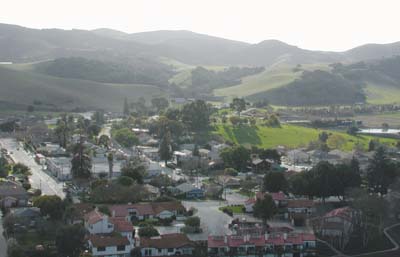
To give the Free Lance a first-hand experience in ultralight
piloting, Pete Marsh
– owner of Alaskan Airborne Adventures – took a reporter on a
ride from his hangar in San Martin to San Juan Bautista in his
sport pilot trike. Since moving back to the area last September,
Marsh has brought his instruction business with him and aims to
continue it in the area he loves.
Editor’s note: This is the first of two parts on a local’s efforts to conduct ultralight instruction here.
HOLLISTER
Circling San Juan Bautista on a partly-cloud day from a few hundred feet above in an open-air experimental plane, flying about 65 mph, pilot Pete Marsh pointed to the house he grew up in.
To give the Free Lance a first-hand experience, Marsh – owner of Alaskan Airborne Adventures – took a reporter on a ride from his hangar in San Martin to San Juan Bautista in his sport pilot trike. Since moving back to the area last September, Marsh has brought his instruction business with him and aims to continue it in the area he loves.
Marsh was born in Hollister and raised in San Juan Bautista. He attended San Benito High School but never graduated, leaving to join the Navy after he turned 18. After being in the Navy, Marsh started flying experimental aircraft. “I started flying these things in the 90s, launching off of mountains,” Marsh said.
After locating to Alaska, Marsh started training pilots in 1997 and had a lot of success for a long time and trained hundreds of students, he said. That is also where Marsh created Alaskan Airborne Adventures, his own business dedicated to teaching pilots and spreading the word about sport piloting, a name that has stuck even with the move back to California.
After the Federal Aviation Administration came out with new rules for sport piloting in 2004, things slowed down for Marsh because “we had trouble meeting the requirement and there were not too many instructors.”
After nearly 30 years of being away from the area, Marsh moved back to Hollister in September with his wife Denise and daughter Victoria.
“It was hard to make a go of it in Alaska – 6 months of dark, snow and cold. We would bundle up and fly in that stuff, sometimes it could be a real drag. But I wanted to come back and do this sort of thing here. It’s a great place for this.”
Marsh said he has always loved this area and wants to work with kids to get more of them flying. He would like to get kids interested in a positive activity like flying and to keep them off of drugs and alcohol.
“Kids like extreme sports, and these airplanes are extreme enough to get them interested,” Marsh said.
Another realm Marsh would like to work with is nonprofits.
“I like to work with the public and I’m interested in nonprofit organizations,” Marsh said. He added that he would like to work with persons with disabilities. “I’m interested in getting these people out and giving them rides.”
Ultralight history and an easier avenue to flying
If he can eventually do that, aspiring pilots here would have an avenue for flying that requires fewer requirements than if they pursue a normal license.
Marsh said that people years ago were legally flying these planes – which resemble hangliders with small engines – without pilot’s licenses but after Sept. 11, 2001, the Federal Aviation Association looked into putting more regulations on these types of planes and decided to require a license for ultralights and sport pilot-type aircraft.
Getting a sport piloting license, however, is nowhere near as difficult to obtain as a normal pilot’s license. Marsh said that to get a license, you need 20 hours of instruction and to pass a written test. He said it costs around $4,000 to get your license compared with the $12,000 it may cost to get a normal pilot’s license.
“The whole idea behind it is to get people flying,” Marsh said. “The FAA did this to invigorate people to start flying again.”
Another non-issue for a sport pilot’s license is the lack of medical testing. Marsh used the example of a candidate who has diabetes. If they were to apply for a pilot’s license, they would be denied on that basis. Sport piloting licenses don’t operate under the same constraints. “You can have some ailments and still fly,” Marsh said.
It also lacks the intensive amount of classes for a normal pilot’s license. Along with the 40 hours of instruction time, one has to attend ground school and take a number of tests, on top of having a medical exam.
Look back Wednesday for Part 2 of this Free Lance story on an ultralight flight instructor attempting to land his business in Hollister.









